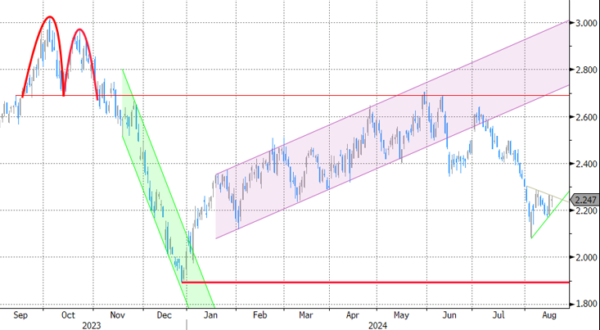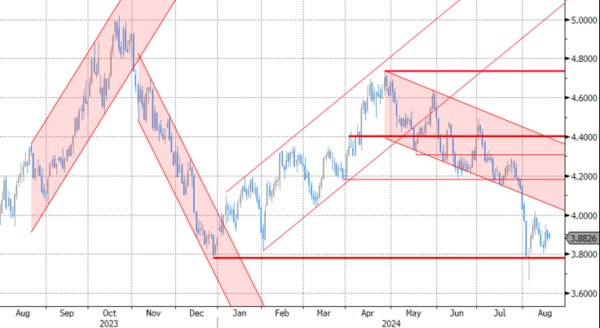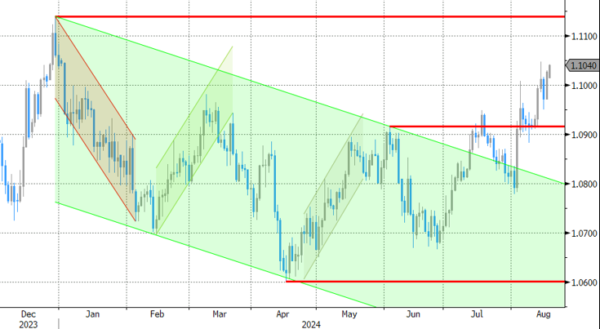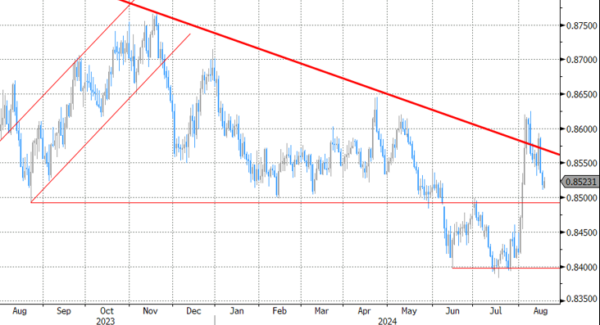Markets
Last week’s US eco data failed to settle the debate on the outcome of the September FOMC meeting. Money markets initially added to 50 bps rate cut bets on slightly below consensus PPI numbers, but later on retraced somewhat after CPI showed continuing disinflation though in line with forecasts. Survey data (Empire Manufacturing), activity figures (retail sales) and labour market data (jobless claims) all helped putting the early August recession scare to bed. Weak US housing data were the odd one out. Attention shifts to the Fed’s Jackson Hole symposium later this week with a keynote speech by Fed Chair Powell on the economic outlook on Friday (4pm CET). In line with guidance at the July meeting, we think he’ll confirm the likelihood of a September policy rate cut. However, we don’t expect him to echo the market drum of kicking things off with a 50 bps move. SF Fed Daly over the weekend also hailed gradualism as the way to approach the cutting cycle with more signs of inflation being under control and the labour market slowing. She stressed that slowing isn’t the same as being weak. Powell won’t formally close the door on 50 bps neither though with plenty of data (ISM’s, payrolls, CPI) still to be released ahead of the September 18 FOMC meeting. Such scenario will keep the dollar in the defensive while preventing a significant return higher in US bond yields. EUR/USD last week moved above the psychologic 1.10 barrier with the December 2023 top at 1.1139 being the next target. General dollar weakness pulls the trade-weighted greenback to 102 for the first time since early January this morning with USD/JPY losing over two big figures at 145.30. It could add to the bullish comeback of (US) stock markets. The S&P 500 and Nasdaq already completely erased the early August market meltdown. Other things to match this week are, the preliminary benchmark revision to Establishment Survey Data (payrolls, risks to significant downward adjustments to past months data), Minutes of the July Fed meeting (both on Wednesday) ECB Q2 wage data and global PMI’s (both on Thursday), Jackson Hole comments in general (Friday) and the Democratic national convention.
News & Views
Rating agency Fitch confirmed Belgium’s AA- credit rating last Friday, but the outlook remains negative. Strong fundamentals are counterbalanced by fiscal challenge. A very high and rising level of public indebtedness and a political and institutional context complicate fiscal adjustment efforts. The negative outlook reflects insufficient fiscal consolidation to achieve debt stabilization in the medium term. Fitch indicates that rising aging costs, high inflation indexation of expenditure and rising debt service costs make a difficult environment for fiscal consolidation. In its baseline scenario, Fitch expects the fiscal deficit to reach 4.5% in 2026 compared to 4.4% in 2023. The no-policy change scenario of the National bank of Belgium expects a 5.5% deficit in 2026. Fitch in its assessment incorporates modest consolidation efforts from the new government but still sees the debt ratio stuck on an upward trajectory, reaching 109.3% in 2026, from 105.2% in 2023. With respect to economic growth, the rating agency plots GDP growth moderating to 1.1% this year and to stay below the country’s potential (1.2%) at 0.9% in 2025 and 1% in 2026. Inflation is expected to average 4.3% this year as the government is rolling back energy support measures, but is seen falling back to 2.8% and 1.6% in 2025 and 2026.
British property website Rightmove states that UK property prices declined 1.5% M/M in August to be 0.8% higher compared to the same month last year (from -0.4% M/M and + 0.4% Y/Y in July). Even so, Rightmove indicated that buyer inquiries in August were 19% higher compared to a year ago (from a 11% Y/Y rise in July). In its assessment, Rightmove director Tim Bannister indicated that “While mortgage rates aren’t yet substantially lower since the rate cut, the fact that the long-hoped-for first cut has finally arrived, and mortgage rates are heading downwards, is positive for home-mover sentiment”.
Graphs
GE 10y yield
The ECB cut policy rates by 25 bps in June. Stubborn inflation (core, services) make follow-up moves less evident. Markets nevertheless price in two to three more cuts for 2024 as disappointing US and unconvincing EMU activity data rolled in, dragging the long end of the curve down. The move accelerated during the early August market meltdown.
US 10y yield
The Fed in its July meeting paved the way for a first cut in September. It turned attentive to risks to the both sides of its dual mandate as the economy is continuing to move better in to balance. Money markets tend to err in favour of a 50 bps lift-off. The pivot weakened the technical picture in US yields with another batch of weak eco data pushing the 10-yr sub 4%.
EUR/USD
EUR/USD moved above the 1.09 resistance area as the dollar lost interest rate support at stealth pace. US recession risks and bets on fast and large (50 bps) rate cuts trumped traditional safe haven flows into USD. EUR/USD 1.1139 (Dec 2023 high) serves as next technical reference.
EUR/GBP
The BoE delivered a hawkish cut in August. Policy restrictiveness will be further unwound gradually 0on a pace determined by a broad range of data. The strategy similar to the ECB’s balances out EUR/GBP in a monetary perspective. Risk-off proved a more important driver of GBP recently, triggering a return from 0.84 towards 0.86.

















